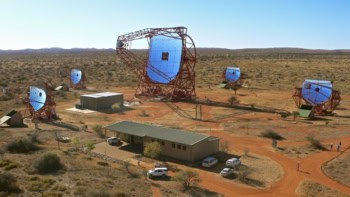
A team of astronomers based in Europe has obtained a three-dimensional view of the innermost material released by a supernova – something never before seen. The researchers discovered a turbulent environment where stellar material is being ejected in a highly asymmetric fashion.
The subject of the study is Supernova 1987A (SN 1987A), located in the nearby Large Magellanic Cloud. Due to its proximity to the Milky Way, SN 1987A has caused a flurry of astronomical interest since it first appeared in 1987. It has been the basis for several remarkable observational “firsts”, including the detection of neutrinos released when its core collapsed, direct exploration of the radioactive elements present during the blast, and it revealed insights into how dust is formed during a supernova explosion.
This latest research, led by Karina Kjaer of Queen’s University, Belfast, looks at the geometry of the supernova blast. Kjaer worked with colleagues from the European Southern Observatory and Stockholm University, Sweden, to image the aftermath of the star’s explosion. This was done using the European Southern Observatory’s Very Large Telescope (VLT) fitted with SINFONI (Spectrograph for INtegral Field Observations in the Near Infrared). This equipment allowed the team to obtain detailed analysis of SN 1987A through use of its very high resolving ability and light filtering system.
Moving outwards freely
The researchers used a technique called Integral Field Spectroscopy, which enabled them to examine several parts of the moving gas ring simultaneously and obtain a 3D picture of the inner band of ejected material. “Because we know that time has passed since the explosion, and because the material is moving outwards freely, we can convert this velocity into a distance,” explains Kjaer. “There is currently no other way to obtain such a comprehensive picture of 87a’s inner ejecta.” The procedure was aided by adaptive optics systems, which make tiny adjustments to the shape of the telescope’s mirrors to counteract the distorting effect of atmospheric turbulence.
The new three-dimensional view shows the explosion to have been faster and stronger in certain directions, leading to an irregular shape – not the symmetrical distribution expected. The innermost material was not ejected as a sphere, but rather in two or more general directions. The significant asymmetry shown in the ejection of the material is a strong indication of the turbulent inner environment of the supernova.
“Although our observations are of one single supernova, the result has a huge impact, in that all supernovae are compared against SN 1987A,” says Kjaer. “Our observations have definitively changed the view of how 87a exploded.”
Massive stars have dramatic deaths
Supernovae result when massive stars reach the end of their lifetime and explode, causing an ejection of huge amounts of stellar material. However, the large interstellar distances involved make opportunities to accurately observe supernovae rare; SN1987A was the first supernova visible to the naked eye in 383 years.
“The new observations of SN 1987A may be very helpful in refining explosion models,” says Richard Scalzo, an astrophysicist at Yale University, who was not involved in this research. Scalzo believes that to improve our understanding of supernovae mechanics we will need to combine observations with 3D models.
The research team has been granted further use of the VLT to observe SN 1987A later this year. The astronomers hope to use brand new instruments to improve the resolution of the image, and include multicolour imaging. “The 3D view of SN 1987A was only possible because of a major advance in technology,” explains Kjaer. “We hope that these new observational techniques will help us continue pushing the knowledge of supernovae.”
This research is described in Astronomy & Astrophysics.



